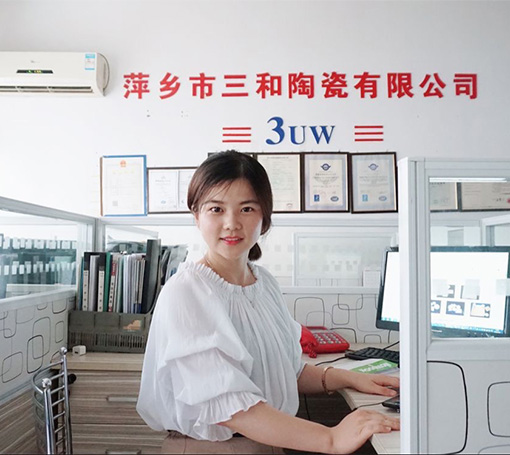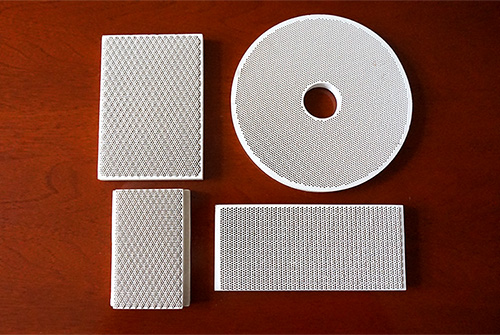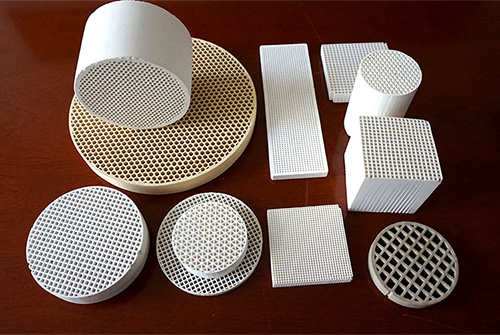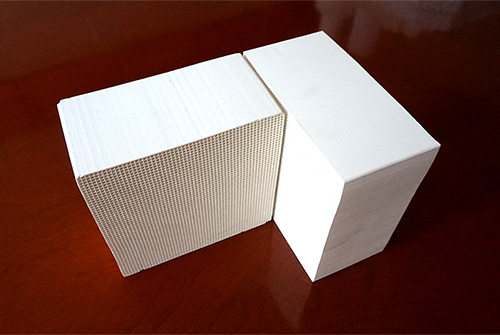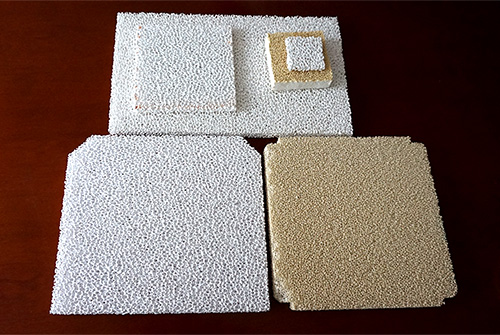Activated Alumina
Activated alumina is a porous, solid form of aluminum oxide, otherwise known as Al2O3 or alumina. This is the same mineral that makes up the precious gems ruby and sapphire, with impurities being the source of the stones' bright colors. After activated alumina has been evacuated of existing moisture by heating it, the high surface area and many pores of the material allow for the uptake of water and other molecules through adsorption.
Activated alumina is manufactured from aluminium hydroxide by dehydroxylating it in a way that produces a highly porous material; this material can have a surface area significantly over 200 m²/g. The compound is used as a desiccant (to keep things dry by absorbing water from the air) and as a filter of fluoride, arsenic and selenium in drinking water. It is made of aluminium oxide (alumina; Al2O3). It has a very high surface-area-to-weight ratio, due to the many "tunnel like" pores that it has. Activated alumina in its phase composition can be represented only by metastable forms (gamma-Al2O3 etc.). Corundum (alpha-Al2O3), the only stable form of aluminum oxide, does not have such a chemically active surface and is not used as a sorbent.
Activated alumina has many different applications, one of the most important of which being desiccation, the adsorption of water. As a desiccant, activated alumina can be used to dry compressed air and other gas and liquid streams. Additionally, the adsorbent is often used to purify gas streams by the selective adsorption of specific molecules. Activated alumina also has water filtration and catalyst applications; for example, it is commonly used in the Claus process, a desulfurizing treatment for natural gas.
What Is The Difference Between Activated Alumina And Molecular Sieve?
While they often perform the same process of adsorbing moisture, activated alumina and molecular sieve differ in many ways. Molecular sieve features pores whose size can be adjusted by ion exchange, allowing them to separate molecules based on size discrimination, a task other adsorbents are not capable of. This is why, for example, molecular sieve is used in the separation of ethanol and water. The sizes of the pores of activated alumina cannot be tailored and are not necessarily uniform. However, activated alumina has its own pros. Activated alumina shows a higher affinity for water than molecular sieve, so it is often used in the drying of various gas and liquid streams, instances when it is important to adsorb the most moisture possible. Its high crush strength allows activated alumina to withstand the high pressures of industrial applications.
Available Types of Activated Alumina
Activated Alumina Fluoride / Arsenic Removal 28x48
Potable water and a cleaner environment.
Lowest cost per 1,000 gallons generated by high capacity and low cost per cubic foot.
Robust material will not deteriorate with backwash.
Works across a broad range of water chemistries.
Iron levels do not affect the arsenic capacity.
Landfillable, disposable without any hazardous wastes.
Certified to NSF/ANSI standard 61, and successfully completed an EPA ETV project.
Advantages of Activated Alumina AAFS50 in Water Redemption Applications.
Ideal and cost effective for a wide variety of uses including - Storm water run off, Remediation, Ballast water, Mine sites, and Phosphate contaminated lakes.
Activated Alumina iron enhanced activated alumina with high arsenic capacity and low cost make it the most economical adsorption route for arsenic removal.
Activated Alumina is designed for single pass use, landfill disposal, passes both TCLP and California WET.
Activated Alumina has also proven efficient in remediation applications including groundwater site clean ups and storm water protection where metals including arsenic, zinc, silica, copper, lead and selenium need to be reduced. It has proven useful in phosphate and nitrate reduction.
Activated Alumina for Air & Gas Streams
Activated Alumina Desiccant is a very porous form of aluminum oxide of high surface area that adsorbs liquids and gases without any change in form. Activated alumina will not soften or disintegrate when immersed in liquids. Activated alumina may be regenerated to its original adsorption efficiency by heating to a temperature between 350-600°F (177-316°C).
Desiccant: Activated alumina as a desiccant, will work by adsorption. The water in the air will stick to the alumina as the air passes through it. The water molecules become trapped so that the air is dried out as it passes through the filter. This process of regenerating the alumina is achieved when the activated alumina desiccant is heated, it will let go of all of the water stored in it, allowing it to be used over and over.
Air and Gas Drying: Nearly all gases and liquids can be dried with F-200. Water removal is often necessary for efficient processing, storage and transportation of fluids. The 3/16" size is normally recommended for vapor phase dehydration applications where pressures drop minimization yet high H 2O adsorptive capacity is desired. The 1/8" and 7 x 14 Tyler mesh sizes are recommended for use in liquid dehydration and other mass transfer limited adsorption applications. Our activated alumina is rapidly becoming the industry standard for drying compressed air. Providing long service life with performance at or below dew point specifications, is a 'peace of mind' product for both large and small dryers. Activated alumina is appropriate for use in dehydrating gases in both thermally regenerative (350 to 600°F) and pressure swing (PSA) modes.
Activated Alumina for Fluoride / Arsenic Removal 14X28
Potable Water and a Cleaner Environment.
Lowest cost per 1,000 gallons generated by high capacity and low cost per cubic foot.
Robust material will not deteriorate with backwash.
Works across a broad range of water chemistries.
Iron levels do not affect the arsenic capacity.
Landfillable, disposable without any hazardous wastes.
Certified to NSF/ANSI standard 61, and successfully completed an EPA ETV project.
Fluoride & Arsenic Removal for Water Treatment.
We are an adsorbent of metals including fluoride from potable water. Regeneration is normally used to operate at the most cost efficient levels.
Fluorograde is used to simultaneously lower fluoride and arsenic to acceptable levels in one treatment.
Activated Alumina Desiccant
Activated alumina Is a high-surface-area, highly porous form of aluminum oxide. It can adsorb gases and liquids without changing its form. It works as a desiccant through adsorption. As air enters into the pores of the alumina, the water in the air becomes trapped and the air that continues to pass through an activated alumina filter is dried out. Even if immersed in a liquid, Activate Alumina will not fall apart or soften.
You can restore the original adsorption efficiency of activated alumina by heating it to any temperature from 350° to 600°F (177° to 316°C). When the desiccant is heated as described above, the water stored in it is released. This means that filters with AA can be reused over and over again.
Our Activated Alumina is specifically designed to have a high crush strength and low dust content, making it ideal for the strain of industrial applications. It is available in a variety of bead sizes to fit your specific drying application.
 English
English Español
Español Français
Français Русский
Русский
